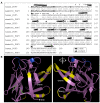Genetic variation at hair length candidate genes in elephants and the extinct woolly mammoth
- PMID: 19747392
- PMCID: PMC2754481
- DOI: 10.1186/1471-2148-9-232
Genetic variation at hair length candidate genes in elephants and the extinct woolly mammoth
Abstract
Background: Like humans, the living elephants are unusual among mammals in being sparsely covered with hair. Relative to extant elephants, the extinct woolly mammoth, Mammuthus primigenius, had a dense hair cover and extremely long hair, which likely were adaptations to its subarctic habitat. The fibroblast growth factor 5 (FGF5) gene affects hair length in a diverse set of mammalian species. Mutations in FGF5 lead to recessive long hair phenotypes in mice, dogs, and cats; and the gene has been implicated in hair length variation in rabbits. Thus, FGF5 represents a leading candidate gene for the phenotypic differences in hair length notable between extant elephants and the woolly mammoth. We therefore sequenced the three exons (except for the 3' UTR) and a portion of the promoter of FGF5 from the living elephantid species (Asian, African savanna and African forest elephants) and, using protocols for ancient DNA, from a woolly mammoth.
Results: Between the extant elephants and the mammoth, two single base substitutions were observed in FGF5, neither of which alters the amino acid sequence. Modeling of the protein structure suggests that the elephantid proteins fold similarly to the human FGF5 protein. Bioinformatics analyses and DNA sequencing of another locus that has been implicated in hair cover in humans, type I hair keratin pseudogene (KRTHAP1), also yielded negative results. Interestingly, KRTHAP1 is a pseudogene in elephantids as in humans (although fully functional in non-human primates).
Conclusion: The data suggest that the coding sequence of the FGF5 gene is not the critical determinant of hair length differences among elephantids. The results are discussed in the context of hairlessness among mammals and in terms of the potential impact of large body size, subarctic conditions, and an aquatic ancestor on hair cover in the Proboscidea.
Figures




Similar articles
-
Genomic DNA sequences from mastodon and woolly mammoth reveal deep speciation of forest and savanna elephants.PLoS Biol. 2010 Dec 21;8(12):e1000564. doi: 10.1371/journal.pbio.1000564. PLoS Biol. 2010. PMID: 21203580 Free PMC article.
-
Sequencing the nuclear genome of the extinct woolly mammoth.Nature. 2008 Nov 20;456(7220):387-90. doi: 10.1038/nature07446. Nature. 2008. PMID: 19020620
-
A comprehensive genomic history of extinct and living elephants.Proc Natl Acad Sci U S A. 2018 Mar 13;115(11):E2566-E2574. doi: 10.1073/pnas.1720554115. Epub 2018 Feb 26. Proc Natl Acad Sci U S A. 2018. PMID: 29483247 Free PMC article.
-
Elephant natural history: a genomic perspective.Annu Rev Anim Biosci. 2015;3:139-67. doi: 10.1146/annurev-animal-022114-110838. Epub 2014 Dec 8. Annu Rev Anim Biosci. 2015. PMID: 25493538 Review.
-
The mastodon mitochondrial genome: a mammoth accomplishment.Trends Genet. 2008 Feb;24(2):49-52. doi: 10.1016/j.tig.2007.11.005. Epub 2008 Jan 14. Trends Genet. 2008. PMID: 18192067 Review.
Cited by
-
Comprehensive profiling of retroviral integration sites using target enrichment methods from historical koala samples without an assembled reference genome.PeerJ. 2016 Mar 28;4:e1847. doi: 10.7717/peerj.1847. eCollection 2016. PeerJ. 2016. PMID: 27069793 Free PMC article.
-
Biogeography and taxonomy of extinct and endangered monk seals illuminated by ancient DNA and skull morphology.Zookeys. 2014 May 14;(409):1-33. doi: 10.3897/zookeys.409.6244. eCollection 2014. Zookeys. 2014. PMID: 24899841 Free PMC article.
-
CRISPR/Cas9-mediated Disruption of Fibroblast Growth Factor 5 in Rabbits Results in a Systemic Long Hair Phenotype by Prolonging Anagen.Genes (Basel). 2020 Mar 11;11(3):297. doi: 10.3390/genes11030297. Genes (Basel). 2020. PMID: 32168764 Free PMC article.
-
Evolutionary Relationships among Extinct and Extant Sloths: The Evidence of Mitogenomes and Retroviruses.Genome Biol Evol. 2016 Feb 14;8(3):607-21. doi: 10.1093/gbe/evw023. Genome Biol Evol. 2016. PMID: 26878870 Free PMC article.
-
Complementary evolution of coding and noncoding sequence underlies mammalian hairlessness.Elife. 2022 Nov 7;11:e76911. doi: 10.7554/eLife.76911. Elife. 2022. PMID: 36342464 Free PMC article.
References
-
- Hattori Y, Yamasaki M, Itoh N. The rat FGF-5 mRNA variant generated by alternative splicing encodes a novel truncated form of FGF-5. Biochim Biophys Acta. 1996;1306:31–33. - PubMed
Publication types
MeSH terms
Substances
LinkOut - more resources
Full Text Sources
Miscellaneous

